Should I Continue to Use Oil Stabilzer if I Use Synthetic Oil
Almost everyone who's into cars has an older vehicle that they love. Whether it's the feeling that they get behind the wheel or the way the car looks parked in their driveway, they pour their time and effort into maintaining the car and keeping it looking like it's just been driven off of the lot. For your own classic car or hot rod, you want the best, and zinc oil additives are the types of products that will help you give your car the best protection possible.
There are numerous positive effects of zinc additives on older engines, especially those with flat-tappet camshafts. The more you know about the need for anti-wear protection and a zinc additive for old cars, the more you'll realize that you can't just go with any old motor oil on the shelves today.
Instead, you'll need to look for motor oil that provides the same protection that motor oil with zinc for older cars provides, without the negative effects that come with high zinc products. Instead of going with high-zinc motor oil or an oil that's used for more modern cars, you'll likely want to go with a zinc replacement additive, which will provide you with the wear protection you need without the adverse effects of zinc products.
Before you decide on whether or not to use a replacement zinc oil additive or stick to classic zinc formulated motor oil, you'll want to know all the facts about high-zinc motor oils, the effects of zinc additive on old engines and how zinc replacement additives work.
What Is High-Zinc Motor Oil?
High-zinc motor oil is a type of engine oil that uses zinc additives to assist your engine whenever friction becomes an issue. To reduce the added strain on the motor produced by the friction and heat that comes with it, many older car owners choose high-zinc motor oil.
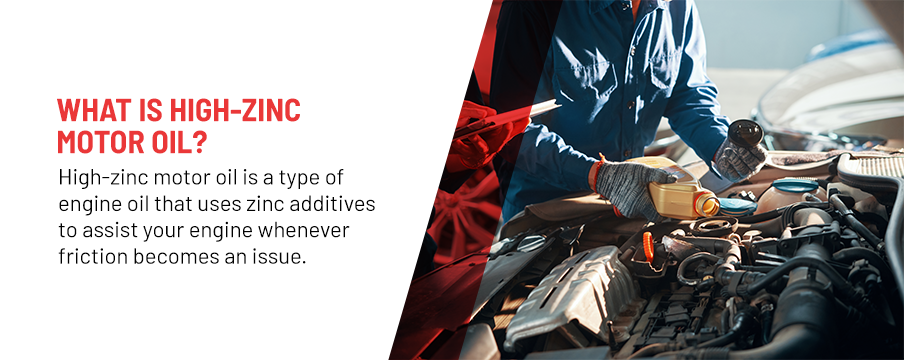
The high zinc content is especially useful for cars that are regularly under strain due to temperature change, harsh road conditions, consistently driving at high speeds and pushing your vehicle to its limits, among other straining factors. In situations where the vehicle is under strain, the zinc contents of the oil offer higher heat resistance and reduced oxidation. These features help car engines last longer and improve their overall capabilities.
The primary role of motor oil with zinc added to it is to ensure that there is no metal-to-metal contact occuring between parts of your engine. The oil accomplishes this by creating a protective film between parts. As it does the job so well, it's often used in high-performance racing cars and other offroad sport vehicles. Due to the engine design of most older vehicles, it's also a popular option for older vehicles with flat tappet camshafts.
Why Camshafts Need Zinc Motor Oil
The camshaft is often the main reason your engine needs either zinc or a zinc replacement additive in the motor oil you feed to it. This need for zinc motor oil comes from the role that a camshaft plays in a flat tappet engine.
When the camshaft rotates, it presses its lobe down to make the engine's valves open. The followers of the camshaft, the pieces of machinery that press against the lobes, then roll or slide along the lobe's surfaces. When the engine gets to a high speed, the friction between the lobes and followers create pressure.
Due to the pressure build-up, motor oil is often squeezed out of the followers and the lobes. As the loss of the oil can cause damage to the vehicle, you'll want motor oil that has anti-wear additives. For older cars that use flat tappet camshaft rather than a more modern rolling camshaft, the anti-wear additive motor oil they use should come with zinc or a zinc replacement additive.
The zinc oil additive in the motor oil will bond to metal parts of the engine, creating an anti-wear coat. This coating will be able to withstand the high pressure and keep your engine running smoothly. In short, flat tappet engines need zinc or a zinc replacement additive in the formula to keep the lifters and camshaft from wearing down before they ought to.
How Do Zinc Additives Work?
The "zinc" in motor oil is often shorthand for zinc dialkyl dithiophosphates, a compound, otherwise known as ZDDP. At times, zinc can also refer to zinc dithiophosphate (ZDTP), which is a phosphorous ingredient often paired with ZDDP for superior protection. Instead of having to say all of that, people in the industry simply refer to ZDDP as zinc.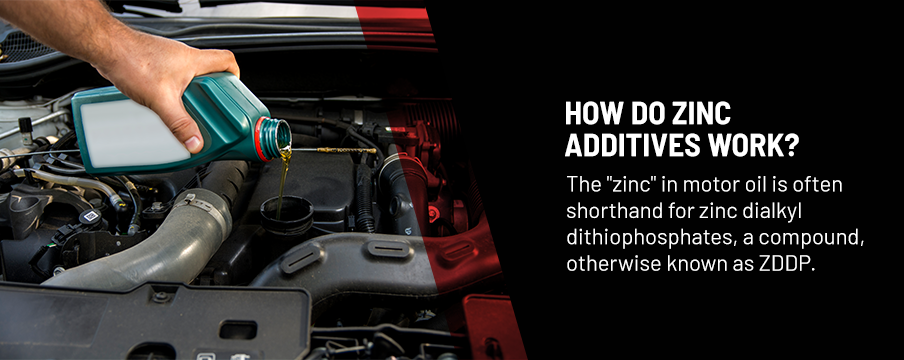
Both ZDDP and ZDTP have been used as anti-wear ingredients for many years in the formulation of motor oils. When zinc and phosphorous ingredients are paired together, they provide the highest level of protection. The effect of the combinations makes ZDDP and ZDTP a natural pairing for anti-wear oils.
Zinc additives work by responding to heat and providing protection for areas where there is a great deal of potentially damaging friction. When the temperature rises and different metal surfaces in the engine start to come closer to one another, ZDDP decomposes due to the heat. This decomposition creates a chemical reaction that protects the metal surfaces of the engine from becoming damaged.
As engine parts move during the vehicle's operation, the rolling or sliding motions of the machinery occur within or on top of the ZDDP anti-wear film. This film then reduces the amount of metal-to-metal contact that occurs during the vehicle operation, reducing wear and tear on the engine. For engines that are designed to generate a great deal of horsepower or that have flat tappet camshafts, the usage of the zinc-containing motor oil is crucial.
Oil testing done on older car engines has found that there is a brief period when the engine is just warming up when it needs to have more lubrication than modern-day, non-zinc motor oil provides. In this start-up period, a non-zinc oil typically won't provide the needed amount of lubrication to keep metal off of metal. The proper oils for these engines will often have increased amounts of ZDDP/ZDTP.
How Do Zinc Additives Affect Old Engines?
If your older vehicle has an engine that uses a flat tappet lifter, it will need to have zinc or a zinc replacement additive in its engine oil. Having zinc in the engine oil will prevent the lifters and camshaft from wearing down prematurely. If your vehicle uses a V6 or V8 engine made before 1988, it's highly likely that it will have been designed to have zinc in the engine oil.
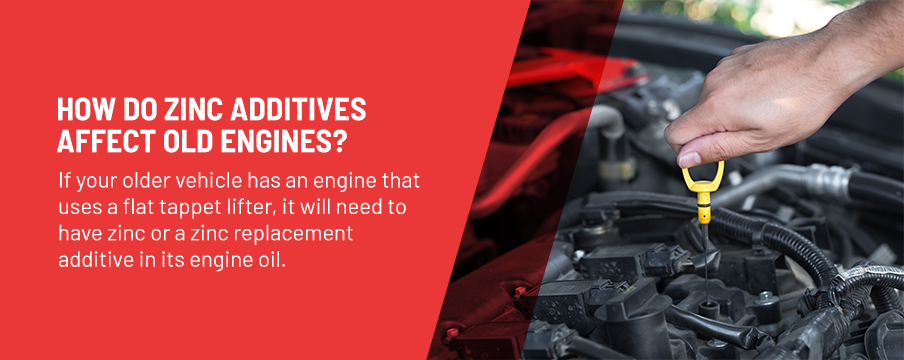
When you look at engines manufactured before the 1980s, you'll find that most had a camshaft design that utilized flat tappets. The flat tappets in these engines create a significant amount of friction. Later roller cam designs would reduce this friction. Still, if you're driving an older car, you're likely using a camshaft designed engine outfitted with flat tappets, making the use of zinc oil additives crucial.
When a flat tappet engine is left without any protection, the friction generated can do a great deal of damage to it. For example, the heat generated by the friction can harm the engine. Along with the heat, the friction can harm the efficiency and the performance of the engine by wearing down the cam.
While there were plenty of motor oils that had zinc additives in them, as engine technology evolved and new engines became standard, modern oil companies began to produce oil without ZDDP or ZDTP. Now, most standard motor oils do not have any zinc additives in them. As such, it's often not wise to use modern oils for classic engines, and you'll usually only see zinc in oil for old cars.
Though zinc additives have gone out of fashion with newer engines, there are still companies that produce them or replacements of them. As you shop for motor oils, you'll not want to pick the first one you see off of the shelf. Instead, you'll need to find motor oil that has appropriate levels of ZDDP and ZDTP or that has formulated a specialized zinc replacement that provides the same or better levels of protection.
Typically, ZDDP and ZDTP are described in parts per million (ppm). If you're set on selecting a zinc oil, you should look to see if the ZDDP level is somewhere between 1,000 ppm and 1,400 ppm. For ZDTP, you'll want to check to see that the phosphorous content is in a similar range as well.
Potential Downsides to Zinc Additives
If zinc additives help older cars run properly, you might be wondering why the industry wouldn't just stick with the formula and keep the zinc levels more or less the same. However, people found that zinc can actually harm the engine. When researchers looked into the effects of zinc, they found that a small amount of motor oil would find its way into the engine's combustion chamber. In this chamber, the zinc in the oil would become ash before being transferred through the exhaust pipe.
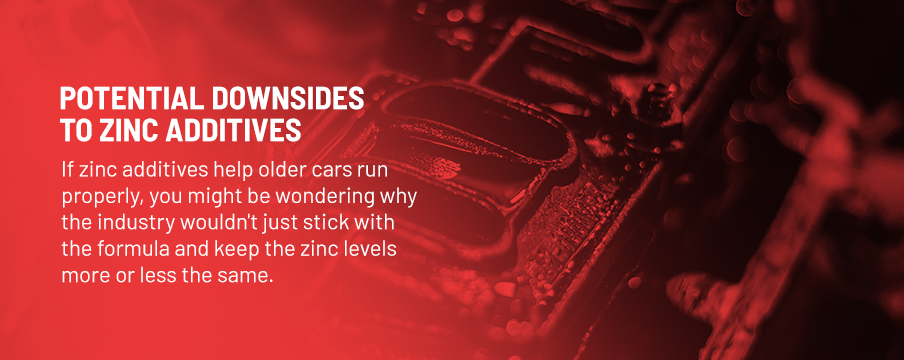
After it had moved through the exhaust pipe, the zinc ash would sometimes come to rest on a catalytic converter. Over time, this ash caused harm to the converter, reducing its effectiveness gradually. This zinc ash can harm the engine's lifespan, forcing you to pay extra money to repair or replace the engine if you don't keep a close watch on it. Along with harming the catalytic converter, the phosphorous in a zinc additive can produce carbon buildup in an engine's valvetrains or bores.
Today, most motor oils have reduced the amount of zinc they use dramatically. In place of zinc, they've added more boron to their oils as a replacement but have not been able to maintain the same quality. This change to non-zinc oil comes with its own downsides, as a non-zinc oil made for modern engines doesn't offer the same level of dry start protection as motor oil using zinc for older engines.
Due to the problems associated with zinc, most motor oil companies will not include any zinc in their formula to protect against damage to the catalytic converter in newer engines. If you're set on using zinc, you'll want to check to see if it's in the 1,000 to 1,400 range mentioned previously. However, older vehicles still need to use the heavy-duty, anti-wear protection of zinc to prevent more significant adverse effects.
Why Use Zinc Replacement Additives?
Zinc replacement additives provide a similar level of lubrication and coating without the negative effects of ZDDP. Zinc can harm the catalyst when it gets on it, resulting in the catalytic converter having a shorter service life and increased emissions. Due to these effects, the OEM engine manufacturers and the EPA have both directed companies to reduce the level of ZDDP in their motor oils and other products.
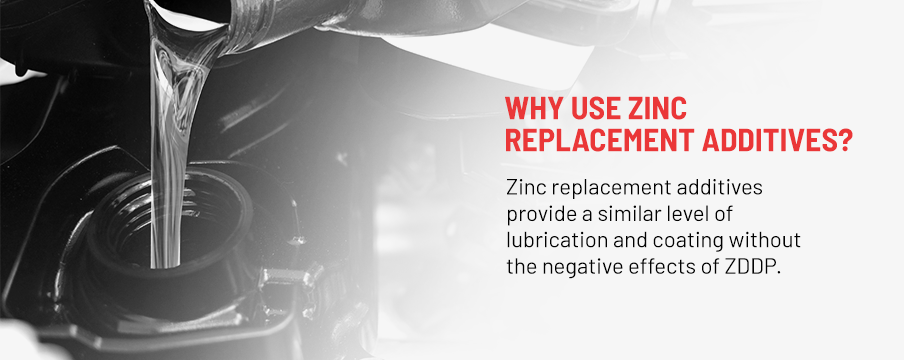
Though there's no doubt these measures are important for protecting consumers' cars from premature damage to catalytic converters, the regulations do leave older engines in a tough situation. They need zinc for the anti-wear protection they provide, but they also need to follow regulations and protect their catalytic converter. While the new regulations are great for reducing environmental impact and keeping engine components safe, any non-roller cam-designed or high-performance engine is left without the wear protection it needs.
The right zinc engine replacement additives will take the zinc and phosphorous out of the oil, while still providing the same high level of protection you've come to expect from a zinc product. For example, Hy-per Lube Zinc Replacement Additive provides users with the extreme pressure wear protection of a zinc product, without the zinc.
While using the product, you can be certain that any rocker arms, lifters or cams you apply the product to will be kept safe without any significant wear problems. As the product doesn't use phosphorous or zinc, you'll also be able to use it without fearing that you're hurting the environment or harming your catalytic converters.
Benefits of Zinc Replacement Additives
Using a zinc replacement additive for old cars comes with several advantages that make it a superior motor oil to anything else on the market for older vehicles. With its ability to provide anti-wear protection for engines even in high-stress environments while doing away with the negative effects of zinc, zinc replacement additives for older cars are a must-have for any responsible classic car owner.
Hy-per Lube Zinc Replacement Additives use a unique Polymer Ester formula that keeps your oil film strong even at high temperatures. With a product like this, you'll receive several engine-related benefits:
- Better protection than ZDDP: A zinc replacement additive offers greater protection without the harmful effects of zinc. The Hy-per Lube Zinc Replacement Additive has been tested and shown to provide better protection than ZDDP based oils.
- No engine harm: Unlike zinc motor oils, a zinc replacement additive will not harm an engine's catalytic converters or emissions controls, increasing your engine's longevity.
- Environmental responsibility: The emissions from older engines that use zinc-based motor oils can be harmful to the environment. A zinc replacement additive improves on zinc motor oils by removing any heavy metal from the formula and reducing harmful emissions.
- Cold-start protection: For vehicles that have gone through a long period of disuse, their engines can often be at risk of damage due to a cold start. With zinc replacement additives in your oil, the cold-start wear on your engine will be reduced significantly.
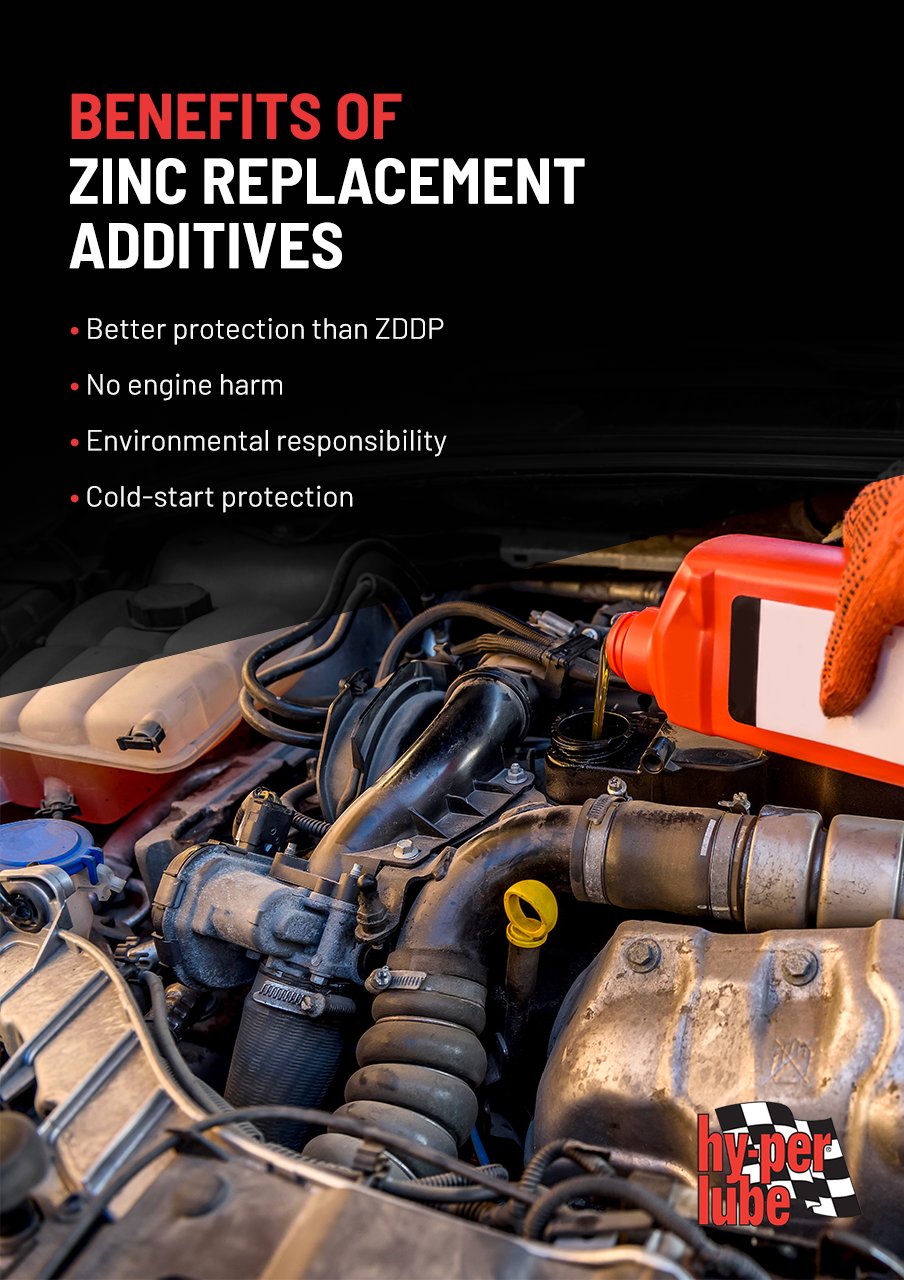
When Should You Use Zinc Additives?
Some experts suggest using a higher level of zinc additives during the break-in period for your engine, as the engine is the most susceptible to uneven wear and the damage that comes with it during that time. Instead of using an oil with a high level of zinc, you can go with a zinc replacement product that offers the same kind of heavy-duty protection.
After the break-in period, you should still use a zinc replacement additive to reduce wear on the car over time. A zinc replacement additive will keep the car running smoothly, reducing the level of friction and heat generated in the engine. If you have a flat tappet cam engine, you'll always need to use a specialty motor oil that uses zinc or a zinc replacement.
Difference Between Flat Tappet Cams and Roller Cams
When you're deciding whether or not you should use zinc additives, you'll need to know what type of engine you have. A flat tappet cam will need zinc additives while a roller cam will not. This differentiation between the two comes down to the way both cams are designed.
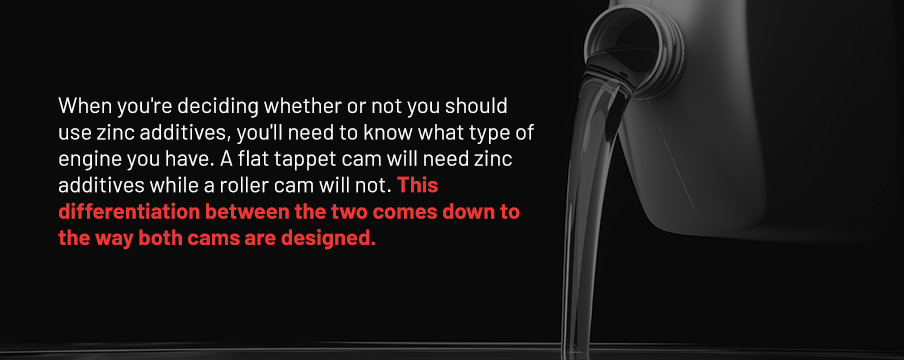
Due to the tappet's flat design, a flat tappet cam is consistently at risk of wearing down. While the engine is on, the cam lobe constantly slides on top of the tappet, generating a great deal of friction and raising the temperature. Without proper lubrication, this friction can end up causing a considerable amount of damage to the vehicle.
More specifically, if you use an oil that doesn't provide enough wear protection, the two metal surfaces that rub against one another will harm the valve operation by wearing down the flat tappet cam. This damage to the valve operation can have several negative effects on the engine. Namely, the engine's efficiency and power will decrease if the flat tappet cam can't lift the valves enough to release exhaust fumes or charge the ignition chamber properly.
If you have a roller cam, you won't have to worry about the problem with friction as much, and due to some of the adverse effects of zinc oil additives, you'll want to avoid using motor oil with lots of zinc additives. A roller cam differs from a flat tappet cam in that it uses rolling contact rather than the flat tappet's sliding contact, reducing friction. As there's less friction in a roller cam engine and zinc can be damaging over time, a roller cam shouldn't use a zinc oil additive.
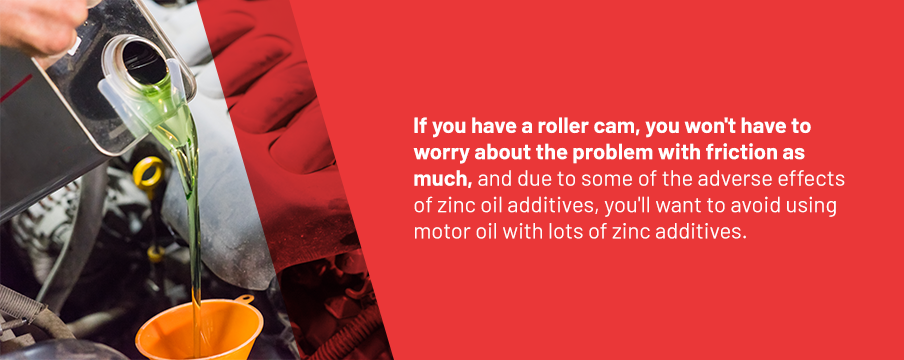
You always need zinc oil additives for flat tappet cams if you want your engine to last as long as possible. Whether you're breaking in the engine or simply maintaining it, you need to use a zinc-containing oil or a zinc replacement additive to protect your vehicle as much as possible. In short, if you use a flat tappet cam, it's recommended that you choose motor oil that contains zinc or a zinc replacement additive, while it's not recommended for a roller cam.
Want to Learn More About Zinc Replacement Additives?
If you're interested in superior protection for your engine, you'll want to learn more about Hy-per Lube's motor oil products, as we are dedicated to crafting products that keep your vehicle running as long as possible. For example, the Hy-per Lube Zinc Replacement Additives provides an excellent alternative to high zinc motor oils. Instead of worrying about zinc damaging your engine over time, you can use a zinc replacement additive that offers greater protection without the negative effects of zinc build-up.
Contact us if you have any questions about the products, as our knowledgeable and friendly staff will be happy to help. If you're interested in making a purchase, you can find a store near you with our store locator.
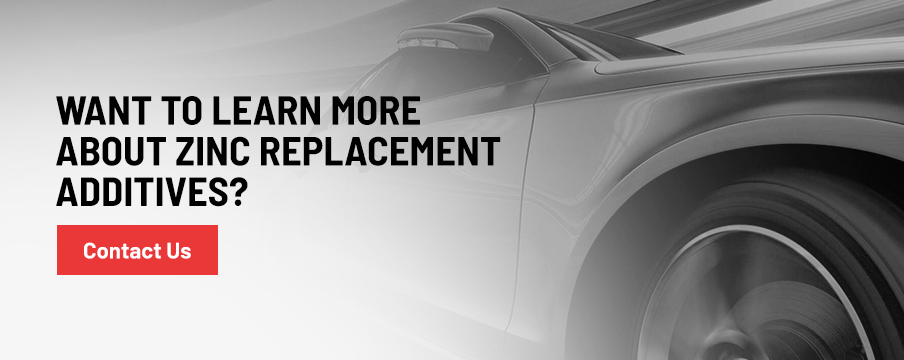
Source: https://rislone.com/blog/engine-oil/the-effects-of-zinc-oil-additives-on-older-engines/
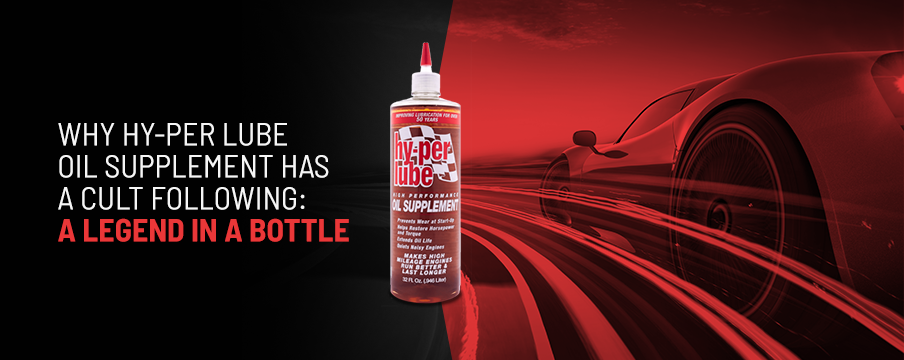
0 Response to "Should I Continue to Use Oil Stabilzer if I Use Synthetic Oil"
Post a Comment